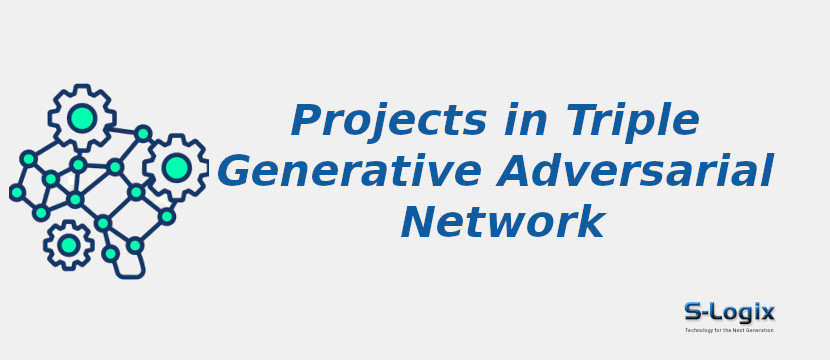Project Background:
Triple Generative Adversarial Networks (Triple-GANs) revolves around advancing generative modeling techniques by introducing a triple-network architecture within the framework of Generative Adversarial Networks (GANs). GANs, known for their ability to generate realistic data samples, consist of a generator and a discriminator network engaged in an adversarial training process. Triple-GANs extend this paradigm by introducing a third network, often called the regulator or moderator. This novel architecture addresses challenges such as mode collapse and lack of diversity in GAN-generated samples. The regulator network plays a crucial role in enhancing the stability and diversity of the generated samples by moderating the interactions between the generator and discriminator. By introducing a triple-network configuration, the project seeks to achieve more fine-grained control over the learning process, enabling diverse and high-quality synthetic data generation. It has implications across various domains, including computer vision, image synthesis, and data augmentation, where the ability to generate realistic and diverse samples is essential for training robust machine learning models.
Problem Statement
- The problem addressed by Triple-GANs lies in the limitations of traditional GAN architectures in generating diverse and high-quality synthetic data.
-
While GANs are powerful in generating realistic samples, they often face challenges such as mode collapse, where the generator fails to capture the full diversity of an underlying data distribution.
-
Additionally, GANs may struggle to balance sample diversity and quality.
-
The problem involves designing an effective interaction between the generator, discriminator, and regulator networks to enhance stability, diversity, and the overall quality of the generated samples.
-
Achieving this balance is crucial for successfully applying generative modeling in various domains, where the ability to produce realistic and diverse synthetic data.
Aim and Objectives
- Develop and enhance Triple-GANs to generate diverse and high-quality synthetic data.
-
Develop an effective triple-network architecture comprising generator, discriminator, and regulator networks.
-
Address mode collapse challenges in GANs by leveraging the regulator network to encourage diverse sample generation.
-
Improve the stability of the generative modeling process by introducing mechanisms that regulate the interactions between the generator and discriminator.
-
To generate realistic and varied synthetic data, achieve a fine balance between sample quality and diversity.
-
Investigate the adaptability of Triple-GANs across various domains, including computer vision and image synthesis.
-
Enhance the utility of Triple-GANs for data augmentation, facilitating the training of more robust machine learning models.
-
Develop and employ appropriate metrics to quantitatively assess the performance of Triple-GANs in generating diverse and high-quality synthetic data.
Contributions to Triple Generative Adversarial Networks
- Designing and refining an innovative triple-network architecture for Triple-GANs, providing a novel configuration of the generator, discriminator, and regulator networks.
-
Developing and contributing strategies to mitigate mode collapse challenges in generative modeling leverages the regulator network to encourage diverse sample generation.
-
Enhancing the overall stability of Triple-GANs by introducing mechanisms that regulate the interactions between the generator and discriminator networks ensures a smoother training process.
-
Developing solutions that strike a fine balance between sample quality and diversity addresses the challenge of achieving realistic and varied synthetic data.
-
Investigating and contributing insights into the adaptability of Triple-GANs across various domains, including computer vision and image synthesis, assessing their performance in diverse application scenarios.
-
Developing and refining data augmentation techniques using Triple-GANs contributes to creating diverse and realistic synthetic datasets that enhance the training of more robust machine learning models.
Deep Learning Algorithms for Triple Generative Adversarial Networks
- Triple-GAN with Multi-Layer Perceptrons (MLP)
-
Convolutional Triple-GAN (Conv-Triple-GAN)
-
Generative Adversarial Transformer (GAT) in Triple-GAN
-
Recurrent Triple-GAN (RNN-Triple-GAN)
-
Triple-GAN with Attention Mechanisms
-
Variational Autoencoder (VAE) combined with Triple-GAN
-
Triple-GAN with Wasserstein GAN (WGAN)
-
Adversarial Autoencoder in Triple-GAN
-
Triple-GAN with Conditional GAN (cGAN)
-
Deep Residual Networks in Triple-GAN
-
Triple-GAN with Long Short-Term Memory (LSTM) Networks
-
InfoGAN integrated into Triple-GAN
-
Triple-GAN with Capsule Networks
-
Stacked Generative Adversarial Networks (Stacked GANs) in Triple-GAN
-
Adversarial Variational Bayes in Triple-GAN
Datasets for Triple Generative Adversarial Networks
- CelebA
-
LSUN (Large-scale Scene Understanding)
-
CIFAR-10
-
MNIST
-
Imagenet
-
Fashion-MNIST
-
LFW (Labeled Faces in the Wild)
-
Omniglot
-
MS COCO (Microsoft Common Objects in Context)
Performance Metrics
- Frechet Inception Distance (FID)
-
Inception Score (IS)
-
Kernel Density Estimation (KDE)
-
Total Variation Distance (TVD)
-
Jensen-Shannon Divergence
-
Wasserstein Distance
-
Area Under the Receiver Operating Characteristic curve (AUC-ROC)
-
Area Under the Precision-Recall curve (AUC-PR)
-
F1 Score
-
Mean Squared Error (MSE)
-
Peak Signal-to-Noise Ratio (PSNR)
Software Tools and Technologies:
Operating System: Ubuntu 18.04 LTS 64bit / Windows 10
Development Tools: Anaconda3, Spyder 5.0, Jupyter Notebook
Language Version: Python 3.9
Python Libraries:
1. Python ML Libraries:
- Scikit-Learn
- Numpy
- Pandas
- Matplotlib
- Seaborn
- Docker
- MLflow
2. Deep Learning Frameworks:
- Keras
- TensorFlow
- PyTorch
